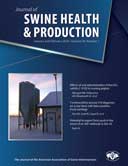Abstract:

Diagnosis of Yersinia enterocolitica serovar O:9 in a commercial 2400-sow farm with false-positive Brucella suis serology using western blot, competitive ELISA, bacterial isolation, and whole genome sequencing
Ross A. Free, DVM; Mark Ladd, DVM; Randy Capsel, PhD; Linda Cox, MS; Jessica Hicks; Kristina Lantz, PhD; Michael J. Neault, DVM; James Kittrell, DVM; Barry J. Meade, DVM
Complete article is available online.
PDF version is available online.
Despite eradication of swine brucellosis from US commercial swine, Brucella suis still exists in feral swine. Therefore, brucellosis surveillance occurs to detect and eliminate any disease introduction from feral swine to domestic swine. As serology for swine brucellosis has imperfect specificity, false-positive serological reactions (FPSRs) occur and true brucellosis infection must be ruled out. In this case report, we detail a process to rule out B suis infection in a commercial sow herd using additional diagnostics including bacterial culture, whole genome sequencing, western blot, and competitive enzyme-linked immunosorbent assay. It was determined Yersinia enterocolitica serovar O:9 caused the FPSRs.
Keywords: Brucella suis, false-positive, Yersinia enterocolitica, serology
![]() Cite as: Free RA, Ladd M, Capsel R, Cox L, Hicks J, Lantz K, Neault MJ, Kittrell J, Meade BJ. Diagnosis of Yersinia enterocolitica serovar O:9 in a commercial 2400-sow farm with false-positive Brucella suis serology using western blot, competitive ELISA, bacterial isolation, and whole genome sequencing. J Swine Health Prod 2020;28(1):21-30.
Cite as: Free RA, Ladd M, Capsel R, Cox L, Hicks J, Lantz K, Neault MJ, Kittrell J, Meade BJ. Diagnosis of Yersinia enterocolitica serovar O:9 in a commercial 2400-sow farm with false-positive Brucella suis serology using western blot, competitive ELISA, bacterial isolation, and whole genome sequencing. J Swine Health Prod 2020;28(1):21-30.
Search the AASV web site for pages with similar keywords.
